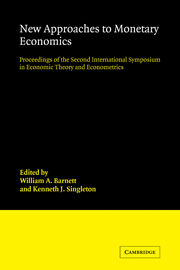 New Approaches to Monetary Economics
New Approaches to Monetary Economics Book contents
- Frontmatter
- Contents
- Editors' introduction
- List of contributors
- Part I Transactions motivated monetary holdings in general equilibrium
- Part II Financial intermediation
- Part III Monetary aggregation theory
- 6 The microeconomic theory of monetary aggregation
- 7 Monetary asset separability tests
- 8 Money demand in open economies: a Divisia application to the U.S. case
- 9 Aggregation of monetary goods: a production model
- 10 Money in the utility function: an empirical implementation
- 11 Comment on papers in Part III
- Part IV Issues on aggregate fluctuations
- Part V Theoretical issues in the foundations of monetary economics and macroeconomics
9 - Aggregation of monetary goods: a production model
Published online by Cambridge University Press: 04 August 2010
- Frontmatter
- Contents
- Editors' introduction
- List of contributors
- Part I Transactions motivated monetary holdings in general equilibrium
- Part II Financial intermediation
- Part III Monetary aggregation theory
- 6 The microeconomic theory of monetary aggregation
- 7 Monetary asset separability tests
- 8 Money demand in open economies: a Divisia application to the U.S. case
- 9 Aggregation of monetary goods: a production model
- 10 Money in the utility function: an empirical implementation
- 11 Comment on papers in Part III
- Part IV Issues on aggregate fluctuations
- Part V Theoretical issues in the foundations of monetary economics and macroeconomics
Summary
Introduction
The objective of this paper is to examine the impact of money on production for the individual financial firm, and to determine whether the monetary goods used can be aggregated on the supply side. Monetary goods are liquid financial assets and liabilities. They include cash as well as demand and time deposits. The financial firm is a profit-maximizing intermediary between borrowers and lenders. The technology of the financial firm includes quantities of monetary goods, other financial goods, and physical goods such as labor and materials. Financial firms are able to set interest rates on monetary goods, and so are not necessarily price takers in such markets.
A test procedure is developed to determine whether monetary goods are separable from nonmonetary goods in production. The test is general. It imposes no functional form restriction on money, and no restriction on which goods can be contained in money. Although the application is to firm data, the test can be applied at the aggregate level. Linear homogeneity of the money index is not required, although it may be imposed by data restrictions.
The financial firm operates to maximize variable profit – revenue less variable cost. The resulting profit function depends on the prices of nonmonetary goods and the quantities of monetary goods. If a monetary index exists at the level of the firm, then marginal rates of substitution or transformation between nonmonetary goods do not depend on quantities of monetary goods.
- Type
- Chapter
- Information
- New Approaches to Monetary EconomicsProceedings of the Second International Symposium in Economic Theory and Econometrics, pp. 200 - 218Publisher: Cambridge University PressPrint publication year: 1987
- 4
- Cited by


